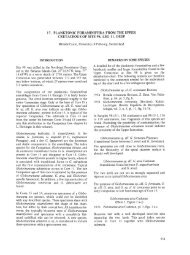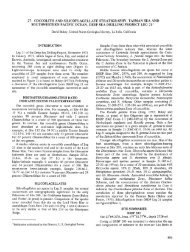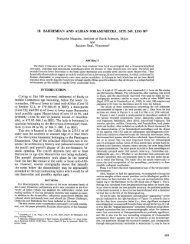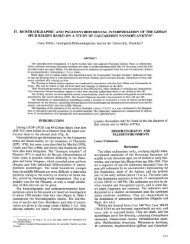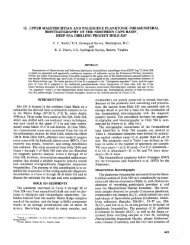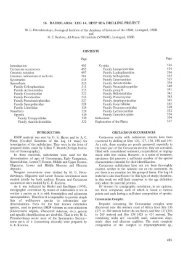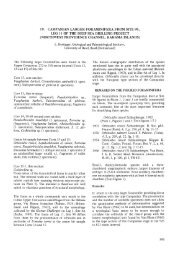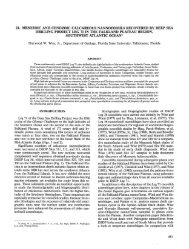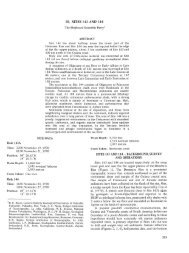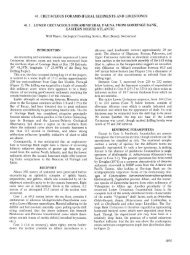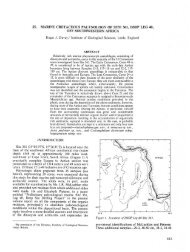1 - Deep Sea Drilling Project
1 - Deep Sea Drilling Project
1 - Deep Sea Drilling Project
You also want an ePaper? Increase the reach of your titles
YUMPU automatically turns print PDFs into web optimized ePapers that Google loves.
Coscinodiscus vetutissimus Pantocsek<br />
(Plate 14, Figure 1)<br />
As illustrated in Kanaya (1971), this species is characterized by<br />
equant, radially aligned areolae. It is not present above the upper Miocene<br />
at DSDP 158, which confirms the earlier disappearance of this<br />
species in the tropical Pacific than in northern areas (Kanaya and<br />
Koizumi, 1970).<br />
Craspedodiscus coscinodiscus Ehrenberg<br />
(Plate 14, Figure 3)<br />
This unusual circular species is easily identified by its distinctive<br />
inflated central area and by the small size of the central area areolae. The<br />
areolae in the brim-like part of the disk are distinctly larger. The upper<br />
natural range of Craspedodiscus coscinodiscus zt DSDP 158 is within the<br />
nannofossil Discoaster exilis Zone; this is comparable to the EM section,<br />
where it ranges through the D. exilis Zone into the adjacent Catinastet<br />
coalitus Zone (Kanaya, 1971; Bukry, unpublished data).<br />
Denticula hustedtii Simonsen and Kanaya<br />
(Plate 14, Figures 4-5)<br />
This small elongate diatom has been well characterized stratigraphically<br />
and taxonomically by Simonsen and Kanaya (1961), Kanaya and<br />
Koizumi (1970), and Kanaya (1971). Determining the full stratigraphic<br />
range of this form requires examination of fine and coarse fractions (HJ.<br />
Schrader, personal communication, 1971). In the present study of coarse<br />
fractions, its range is, nevertheless, comparable to that indicated by<br />
Kanaya and Koizumi from the tropical Pacific. A spot check of coeval<br />
horizons of the Monterey Formation at Newport Beach, California.<br />
shows this and other species of Denticula to be much more abundant<br />
than at DSDP 158.<br />
Denticula lauta Bailey<br />
(Plate 14, Figure 6)<br />
This species is smaller than Denticula hustedtiibut has essentially the<br />
same middle Miocene to lower upper Miocene stratigraphic range at<br />
DSDP 158.<br />
Ethmodiscus rex (Rattray)<br />
(Plate 14, Figure 7)<br />
This large, finely areolate species is represented only as fragments in<br />
the samples examined, but it is a consistent and usually common member<br />
of our middle Miocene to Pleistocene sections. It has been classified as<br />
a typical tropical form by Lohman (1941) and Kanaya and Koizumi<br />
(1966). Resistance of this form to dissolution has been suggested by its<br />
occurrence in H.M.S. Challenger samples from depths of 8185 meters<br />
and 10,505 meters (Wiseman and Hendey, 1953).<br />
Fragilariopsis pliocena Brun<br />
(Plate 14, Figures 8-10)<br />
As tabulated here, this species includes both the long forms illustrated<br />
by Kanaya (1971) and the short forms called Nitzschia praemarina<br />
by Muhina (1969). Both the long and short forms are similarly constructed<br />
and are most common in the same interval—lower Pliocene to<br />
upper Miocene, DSDP 157 (Cores 23 to 35). The stratigraphic relations<br />
of the whole group are currently being worked out by HJ. Schrader<br />
(personal communication, 1972).<br />
Hemidiscus cuneiformis Wallich<br />
(Plate 14, Figures 11-12)<br />
This species is semicircular in plan view and wedge-shaped in side<br />
view. It is considered a typical member of tropical assemblages (Kanaya<br />
and Koizumi, 1966) but does occur rarely in samples from as far north<br />
as Japan (Koizumi, 1968; Jousé et al., 1971). The variable form and<br />
size of tropical assemblages of//, cuneiformis described by Kolbe<br />
(1954) are apparent in the Panama Basin cores. Some variants are<br />
stratigraphically restricted-for instance, large angular forms of the<br />
Miocene at DSDP 158. The distinctive outline of this species and its<br />
variants allows identification by girdle bands alone in poorly preserved<br />
samples. The total stratigraphic range of//, cuneiformis in<br />
our cores is from the middle Miocene upper Craspedodiscus coscinodiscus<br />
Zone through the Pleistocene, although it first becomes<br />
prominent only at the top of the upper Miocene Coscinodiscus<br />
plicatus Zone.<br />
SILICOFLAGELLATE AND DIATOM STRATIGRAPHY<br />
Liostephania sp.<br />
(Plate 15, Figure 1)<br />
As illustrated and discussed by Kolbe (1954), the exact nature of<br />
these silicified disks is uncertain. The single specimen observed in our<br />
samples is reminiscent of Asteromphalus, with slits occurring where<br />
hyaline rays would have been originally. Whether this is a biologically<br />
controlled structure or a preservation artifact is unknown.<br />
Nitzschia marina Grunow<br />
(Plate 15, Figure 2)<br />
This elongate, essentially parallel-sided species is similar in construction<br />
to short and long forms of Fragilariopsis pliocena but lacks their<br />
distinctly convex sides. Kanaya and Koizumi (1970) indicate a Miocene<br />
to Holocene range for N. marina. In the Panama Basin cores, it was<br />
noted in upper Pliocene and higher samples. Lohman (1941) considered<br />
it to be mainly a cool-water species, but it ranges into the tropics and has<br />
been classified as tropical by Kanaya and Koizumi (1966).<br />
Pleurosigma sp.<br />
(Plate 15, Figure 3)<br />
These large, thin, elongate, lozenge-shaped diatoms have a straight<br />
raphe and oblique and transverse striae (see Cupp, 1943). The rare and<br />
sporadic occurrences at DSDP 157 and DSDP 158 range from upper<br />
Miocene to Pleistocene.<br />
Pseudoeunotia doliolus (Wallich)<br />
(Plate 15, Figure 4)<br />
This small, elongate, asymmetric species, as illustrated by Kolbe<br />
(1954), is a meager to rare component noted mainly in the fine fraction<br />
of Pleistocene samples from DSDP 157. Sporadic occurrences in the<br />
coarse fraction are noted in and above the upper upper Miocene, although<br />
the early forms lack the full character of the species and are<br />
transitional from Nitzschia fossilis according to HJ. Schrader (personal<br />
communication, 1972). Kanaya and Koizumi (1970) indicate an upper<br />
Pliocene first occurrence in the tropics, but a lower Pliocene appearance<br />
at higher latitudes. Lohman (1941) considered it a warm-water, littoral<br />
species.<br />
Rhizosolenia bergonii Peragallo<br />
(Plate 15, Figure 5)<br />
As noted by Lohman (1941), this tropical species is usually represented<br />
in sediment only by apical spines. Owing to the small size of the<br />
spines, this species has been noted only rarely in our coarse fractions.<br />
Roperia tesselata (Roper)<br />
(Plate 15, Figures 9-11)<br />
This circular species is characterized by an irregular patchwork quilt<br />
appearance of its areolae alignments. It is considered a tropical to subtropical<br />
species (Kanaya and Koizumi, 1966) but has also been reported<br />
as a characteristic living species in the Central Water Mass of the Pacific<br />
(Venrick, 1971), suggesting a broader temperature range. In the Panama<br />
Basin it first appears near the base of the Pleistocene and is most common<br />
in the upper Pleistocene, which could suggest a general worldwide cooling<br />
in the upper Pleistocene (Burckle, 1971).<br />
Stictodiscus sp. cf. S. californicus Greville<br />
(Plate 16, Figures 1-2)<br />
Included under this taxon are a variety of circular diatoms that are<br />
characterized by elevated radial ridges and sparsely punctate central<br />
areas. No attempt has been made to separate varieties here because the<br />
group is present only in small numbers sporadically throughout the<br />
whole section examined. Stictodiscus has been variously considered to be<br />
littoral, benthonic, or epiphytic. Kolbe (1954) noted it only in cores near<br />
the Islas Galapagos, its occurrence probably representing displacement<br />
from shallower areas.<br />
Stictodiscus trigonus Castracane<br />
(Plate 16, Figures 3-6)<br />
This thick triangular species has been reported from recent dredge<br />
samples (Castracane, 1886) and from Miocene outcrops (Reinhold,<br />
1937). In the Panama Basin, virtually identical forms were noted only<br />
in Pleistocene and middle Miocene samples.<br />
835



